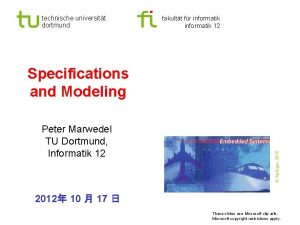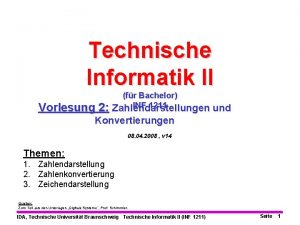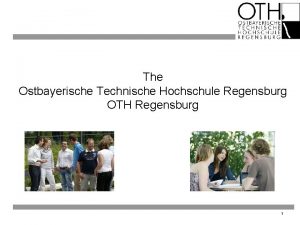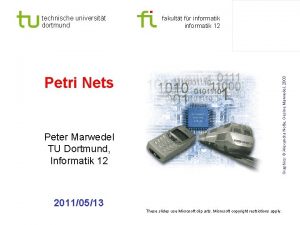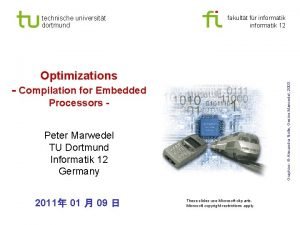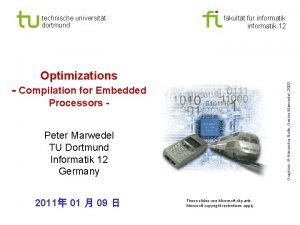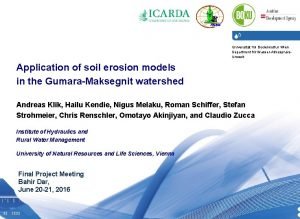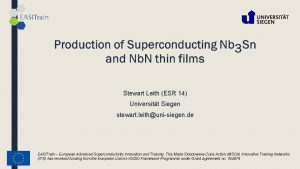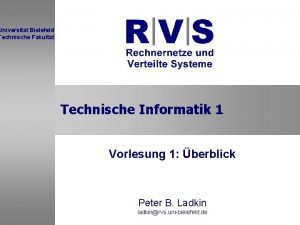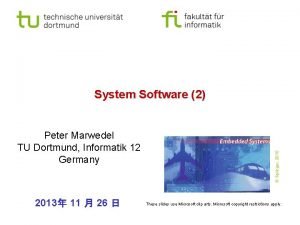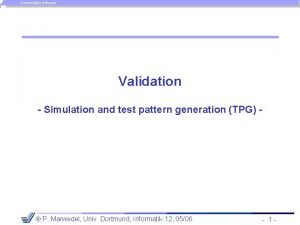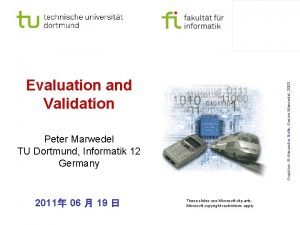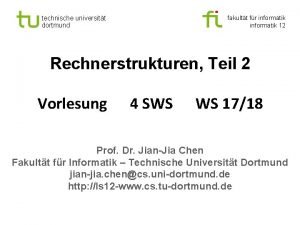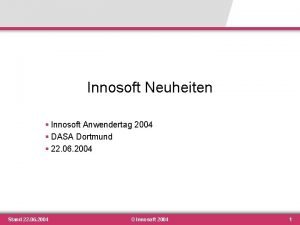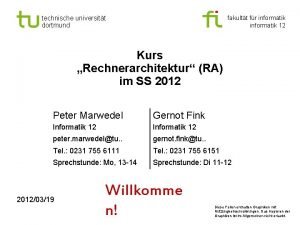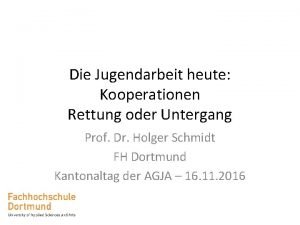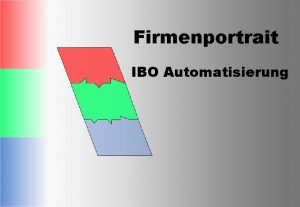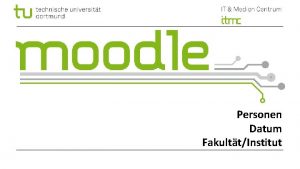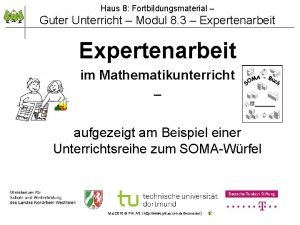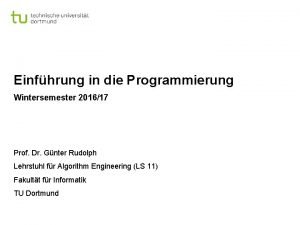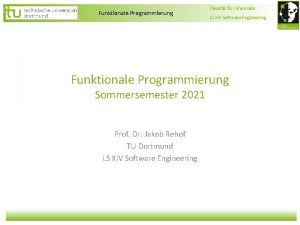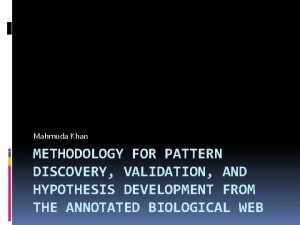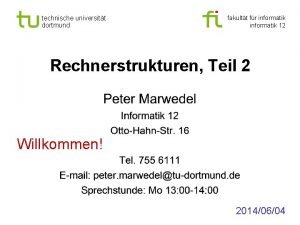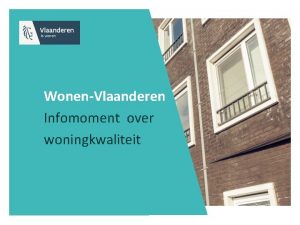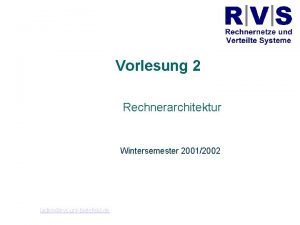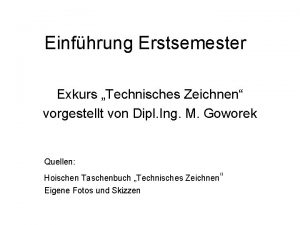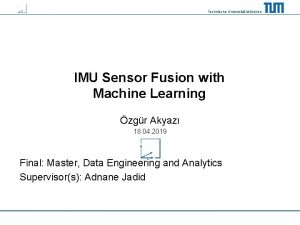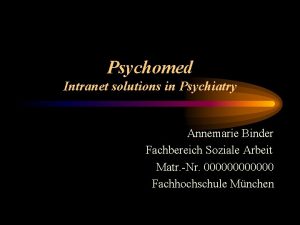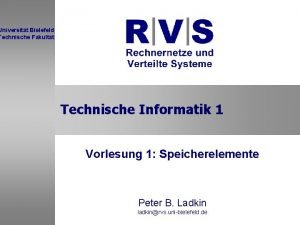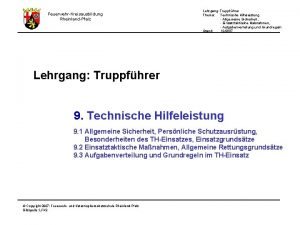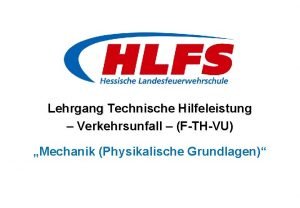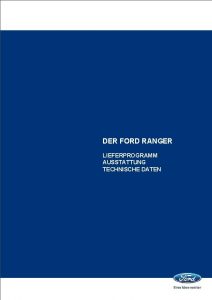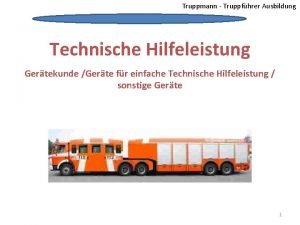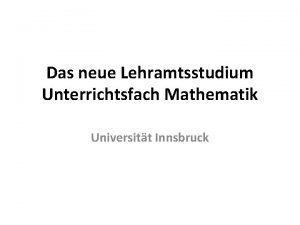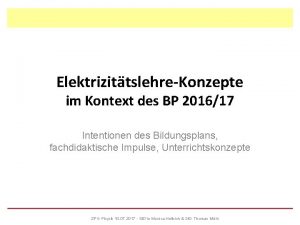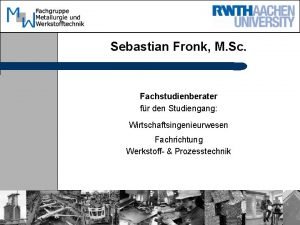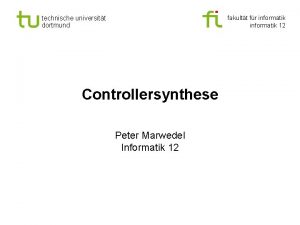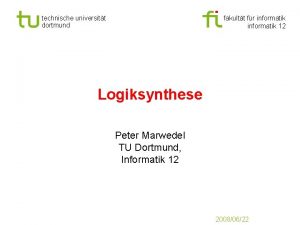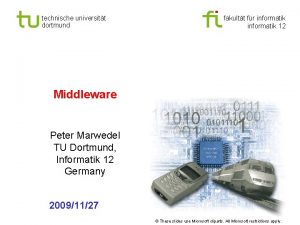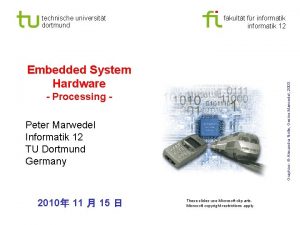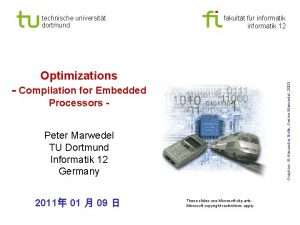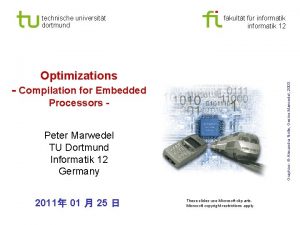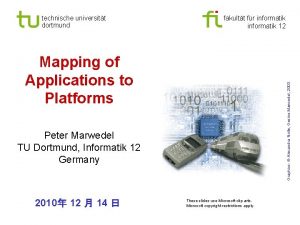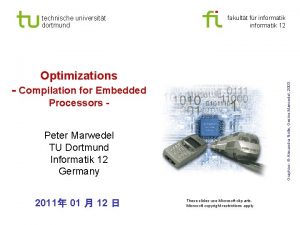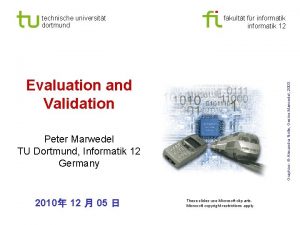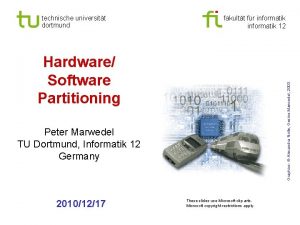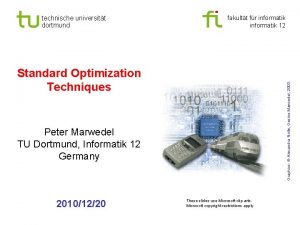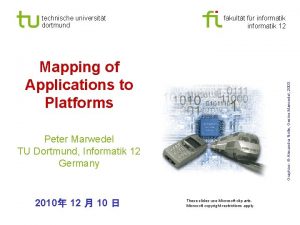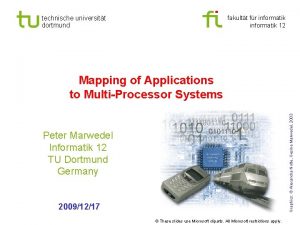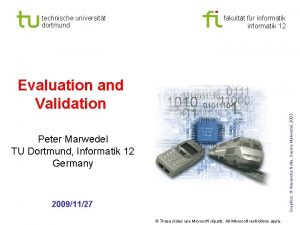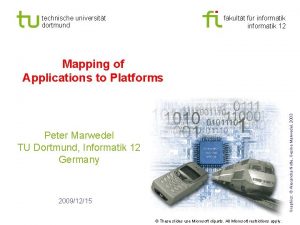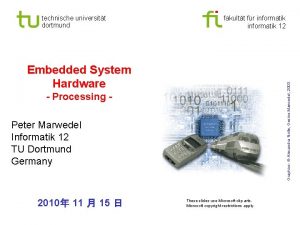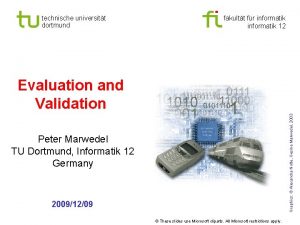technische universitt dortmund fakultt fr informatik 12 Graphics























































![Spec. C [Gajski, Dömer et. al. 2000] § Spec. C is based on the Spec. C [Gajski, Dömer et. al. 2000] § Spec. C is based on the](https://slidetodoc.com/presentation_image_h2/9db567ddd1d13f4b679074819667e168/image-56.jpg)




- Slides: 60

technische universität dortmund fakultät für informatik 12 Graphics: © Alexandra Nolte, Gesine Marwedel, 2003 Discrete Event Modelling Peter Marwedel TU Dortmund, Informatik 12 2010/10/28 These slides use Microsoft clip arts. Microsoft copyright restrictions apply.

Models of computation considered in this course Communication/ local computations Shared memory Undefined components Plain text, use cases | (Message) sequence charts Communicating finite State. Charts state machines Data flow (Not useful) Petri nets Discrete event (DE) model Message passing Synchronous | Asynchronous VHDL*, Verilog*, System. C*, … Von Neumann model C, C++, Java SDL Kahn networks, SDF C/E nets, P/T nets, … Only experimental systems, e. g. distributed DE in Ptolemy C, C++, Java with libraries CSP, ADA | * Classification based on implementation technische universität dortmund fakultät für informatik p. marwedel, informatik 12, 2010 - 2 -

Discrete event semantics Basic discrete event (DE) semantics § Queue of future actions, sorted by time § Loop: • Fetch next entry from queue • Perform function as listed in entry • May include generation of new entries § Until termination criterion = true queue 6 a 5 b 7 c 8 technische universität dortmund 5 10 13 15 19 a: =5 b: =7 c: =8 a: =6 a: =9 fakultät für informatik p. marwedel, informatik 12, 2010 time action - 3 -

HDLs using discrete event (DE) semantics Used in hardware description languages (HDLs): Description of concurrency is a must for HW description languages! § Many HW components are operating concurrently § Typically mapped to “processes“ § These processes communicate via “signals“ § Examples: • MIMOLA [Zimmermann/Marwedel], ~1975 • … • VHDL (very prominent example in DE modeling) One of the 3 most important HDLs: VHDL, Verilog, System. C technische universität dortmund fakultät für informatik p. marwedel, informatik 12, 2010 - 4 -

VHDL = VHSIC hardware description language VHSIC = very high speed integrated circuit 1980: Def. started by US Dept. of Defense (Do. D) in 1980 1984: first version of the language defined, based on ADA (which in turn is based on PASCAL) 1987: revised version became IEEE standard 1076 1992: revised IEEE standard 1999: VHDL-AMS: includes analog modeling 2006: Major extensions technische universität dortmund fakultät für informatik p. marwedel, informatik 12, 2010 - 5 -

Simple example (VHDL notation) S a gate 1: b R process (a, b) begin c <= a nor b; end; a gate 2: c b process (a, b) begin c <= a nor b; end; c Processes will wait for changes on their input ports. If they arrive, processes will wake up, compute their code and deposit changes of output signals in the event queue and wait for the next event. If all processes wait, the next entry will be taken from the event queue. technische universität dortmund fakultät für informatik p. marwedel, informatik 12, 2010 00 01 00 11 - 6 -

VHDL processes Delays allowed: process (a, b) begin c <= a nor b after 10 ns; end; Equivalent to process begin c <= a nor b after 10 ns; wait on a, b; end; technische universität dortmund fakultät für informatik § <=: signal assignment operator § Each executed signal assignment will result in adding entries in the projected waveform, as indicated by the (optional) delay time § Implicit loop around the code in the body § Sensitivity lists are a shorthand for a single wait on-statement at the end of the process body p. marwedel, informatik 12, 2010 - 7 -

Entities and architectures § § In VHDL, HW components correspond to “entities” Entities comprise processes Each design unit is called an entity. Entities are comprised of entity declarations and one or several architectures. Each architecture includes a model of the entity. By default, the most recently analyzed architecture is used. The use of another architecture can be requested in a configuration. technische universität dortmund fakultät für informatik p. marwedel, informatik 12, 2010 - 8 -

The full adder as an example entity full_adder is port(a, b, carry_in: in Bit; -- input ports sum, carry_out: out Bit); --output ports end full_adder; architecture behavior of full_adder is begin sum <= (a xor b) xor carry_in after 10 ns; carry_out <= (a and b) or (a and carry_in) or (b and carry_in) after 10 ns; end behavior; technische universität dortmund fakultät für informatik p. marwedel, informatik 12, 2010 - 9 -

The full adder as an example - Architectures Architecture = Architecture header + architectural bodies Architectural bodies can be - behavioral bodies or - structural bodies. Bodies not referring to hardware components are called behavioral bodies. architecture behavior of full_adder is begin sum <= (a xor b) xor carry_in after 10 Ns; carry_out <= (a and b) or (a and carry_in) or (b and carry_in) after 10 Ns; end behavior; technische universität dortmund fakultät für informatik p. marwedel, informatik 12, 2010 -

The full adder as an example - Simulation results - technische universität dortmund fakultät für informatik p. marwedel, informatik 12, 2010 - 11 -

Structural bodies architecture structure of full_adder is component half_adder port (in 1, in 2: in Bit; carry: out Bit; sum: out Bit); end component; component or_gate port (in 1, in 2: in Bit; o: out Bit); end component; signal x, y, z: Bit; -- local signals begin -- port map section i 1: half_adder port map (a, b, x, y); i 2: half_adder port map (y, carry_in, z, sum); i 3: or_gate port map (x, z, carry_out); end structure; technische universität dortmund fakultät für informatik p. marwedel, informatik 12, 2010 - 12 -

VHDL processes Processes model parallelism in hardware. General syntax: label: --optional process declarations --optional begin statements --optional end process a <= b after 10 ns is equivalent to process begin a <= b after 10 ns end technische universität dortmund fakultät für informatik p. marwedel, informatik 12, 2010 - 13 -

Assignments 2 kinds of assignments: § Variable assignments Syntax: variable : = expression; § Signal assignments Syntax: signal <= expression; signal <= expression after delay; signal <= transport expression after delay; signal <= reject time inertial expression after delay; Possibly several assignments to 1 signal within 1 process. For each signal there is one driver process. Driver stores information about the future of signal, the so-called projected waveform. technische universität dortmund fakultät für informatik p. marwedel, informatik 12, 2010 - 14 -

Adding entries in the projected waveform § Each executed signal assignment will result in adding entries in the projected waveform, as indicated by the delay time, e. g. : output <= ‘ 0’ after 5 ns, ‘ 1’ after 10 ns; technische universität dortmund fakultät für informatik p. marwedel, informatik 12, 2010 - 15 -

1. Transport delay signal <= transport expression after delay; This corresponds to models for simple wires Pulses will be propagated, no matter how short they are. Example: c <= transport a or b after 10 ns; Pulse of 5 ns technische universität dortmund fakultät für informatik 80 a b c 60 OR gate c 40 1 20 a b p. marwedel, informatik 12, 2010 ns - 16 -

2. Inertial delay § By default, inertial delay is assumed. § Suppression of all “spikes” shorter than the delay, resp. shorter than the indicated suppression threshold. § Inertial delay models the behavior of gates. Example: c <= a or b after 10 ns; No pulse of 5 ns 80 a b c 60 OR gate c 40 1 20 a b ns § Tricky rules for removing events from projected waveform technische universität dortmund fakultät für informatik p. marwedel, informatik 12, 2010 - 17 -

Wait-statements Four possible kinds of wait-statements: § wait on signal list; • wait until signal changes; • Example: wait on a; § wait until condition; • wait until condition is met; • Example: wait until c='1'; § wait for duration; • wait for specified amount of time; • Example: wait for 10 ns; § wait; • suspend indefinitely technische universität dortmund fakultät für informatik p. marwedel, informatik 12, 2010 - 18 -

Sensitivity lists are a shorthand for a single wait onstatement at the end of the process body: process (x, y) begin prod <= x and y ; end process; is equivalent to process begin prod <= x and y ; wait on x, y; end process; technische universität dortmund fakultät für informatik p. marwedel, informatik 12, 2010 - 19 -

VHDL semantics: global control According to the original VHDL standards document: The execution of a model consists of an initialization phase followed by the repetitive execution of process statements in the description of that model. Initialization phase executes each process once. technische universität dortmund fakultät für informatik p. marwedel, informatik 12, 2010 - 20 -

VHDL semantics: initialization At the beginning of initialization, the current time, Tc is 0 ns. § The … effective value of each explicitly declared signal are computed, and the current value of the signal is set to the effective value. … § Each. . . process … is executed until it suspends. § The time of the next simulation cycle (… in this case … the 1 st cycle), Tn is calculated according to the rules of step f of the simulation cycle, below. technische universität dortmund fakultät für informatik p. marwedel, informatik 12, 2010 - 21 -

VHDL semantics: The simulation cycle (1) According to the standard, the simulation cycle is as follows: a) Stop if Tn= time‘high and “nothing else is to be done” at Tn. The current time, Tc is set to Tn. ? technische universität dortmund fakultät für informatik p. marwedel, informatik 12, 2010 - 22 -

VHDL semantics: The simulation cycle (2) b) Each active explicit signal in the model is updated. (Events may occur as a result. ) Previously computed entries in the queue are now assigned if their time corresponds to the current time Tc. New values of signals are not assigned before the next simulation cycle, at the earliest. Signal value changes result in events enable the execution of processes that are sensitive to that signal. c). . technische universität dortmund fakultät für informatik p. marwedel, informatik 12, 2010 - 23 -

VHDL semantics: The simulation cycle (3) d) P sensitive to s: if event on s in current cycle: P resumes. e) Each. . . process that has resumed in the current simulation cycle is executed until it suspends*. *Generates future values for signal drivers. e e d technische universität dortmund fakultät für informatik p. marwedel, informatik 12, 2010 - 24 -

VHDL semantics: The simulation cycle (4) f f) Time Tn of the next simulation cycle = earliest of 1. time‘high (end of simulation time). 2. The next time at which a driver becomes active 3. The next time at which a process resumes (determined by wait for statements). Next simulation cycle (if any) will be a delta cycle if Tn = Tc. technische universität dortmund fakultät für informatik p. marwedel, informatik 12, 2010 - 25 -

-simulation cycles … Next simulation cycle (if any) will be a delta cycle if Tn = Tc. Delta cycles are generated for delay-less models. There is an arbitrary number of cycles between any 2 physical time instants: In fact, simulation of delay-less hardware loops might not terminate (don’t even advance Tc). technische universität dortmund fakultät für informatik p. marwedel, informatik 12, 2010 - 26 -

-simulation cycles Simulation of an RS-Flipflop 2 nd 0000 00011 1 st 3 rd 11000 0111 0 ns+2 0 ns+3 R 1 1 S 0 0 Q 1 0 0 0 n. Q 0 0 1 1 technische universität dortmund fakultät für informatik gate 1: process (S, Q) begin n. Q <= S nor Q; end; gate 2: process (R, n. Q) begin Q <= R nor n. Q; end; cycles reflect the fact that no real gate comes with zero delay. should delay-less signal assignments be allowed at all? p. marwedel, informatik 12, 2010 - 27 -

-simulation cycles and determinate simulation semantics Semantics of a <= b; b <= a; ? Separation into 2 simulation phases results in determinate semantics ( State. Mate). technische universität dortmund fakultät für informatik p. marwedel, informatik 12, 2010 - 28 -

technische universität dortmund fakultät für informatik 12 Peter Marwedel TU Dortmund, Informatik 12 2009/10/29 Graphics: © Alexandra Nolte, Gesine Marwedel, 2003 Multi-valued logic and standard IEEE 1164

Abstraction of electrical signals § Complete analog simulation at the circuit level would be time-consuming We try to use digital values and DE simulation as long as possible However, using just 2 digital values would be too restrictive (as we will see) technische universität dortmund fakultät für informatik p. marwedel, informatik 12, 2010 - 30 -

How many logic values for modeling ? Two ('0' and '1') or more? If real circuits have to be described, some abstraction of the driving strength is required. We introduce the distinction between: § the logic level (as an abstraction of the voltage) and § the strength (as an abstraction of the current drive capability) of a signal. The two are encoded in logic values. CSA (connector, switch, attenuator) - theory [Hayes] technische universität dortmund fakultät für informatik p. marwedel, informatik 12, 2010 - 31 -

1 signal strength Logic values '0' and '1'. Both of the same strength. Encoding false and true, respectively. technische universität dortmund fakultät für informatik p. marwedel, informatik 12, 2010 - 32 -

2 signal strengths Many subcircuits can effectively disconnect themselves from the rest of the circuit (they provide “high impedance“ values to the rest of the circuit). Example: subcircuits with open collector or tri-state outputs. technische universität dortmund fakultät für informatik Open-collector p. marwedel, informatik 12, 2010 - 33 -

Tri. State circuits n. MOS-Tristate CMOS-Tristate Source: http: //www-unix. oit. umass. edu/ ~phys 532/lecture 3. pdf We introduce signal value 'Z', meaning “high impedance “ technische universität dortmund fakultät für informatik p. marwedel, informatik 12, 2010 - 34 -

2 signal strengths (cont’ed) We introduce an operation #, which generates the effective signal value whenever two signals are connected by a wire. #('0', 'Z')='0'; #('1', 'Z')='1'; '0' and '1' are “stronger“ than 'Z' 1 strength In order to define #('0', '1'), we introduce 'X', denoting an undefined signal level. 'X' has the same strength as '0' and '1'. Hasse diagram technische universität dortmund According to the partial order in the diagram, # returns the larger of the two arguments. fakultät für informatik p. marwedel, informatik 12, 2010 - 35 -

Application example input(s) signal value on bus = #(value from left subcircuit, value from right subcircuit) #('Z', value from right subcircuit) value from right subcircuit “as if left circuit were not there“. technische universität dortmund fakultät für informatik p. marwedel, informatik 12, 2010 - 36 -

3 signal strengths Current values insufficient for describing real circuits: Depletion transistor contributes a weak value to be considered in the #-operation for signal A Introduction of 'H', denoting a weak signal of the same level as '1'. #('H', '0')='0'; #('H', 'Z') = 'H' technische universität dortmund fakultät für informatik p. marwedel, informatik 12, 2010 - 37 -

3 signal strengths There may also be weak signals of the same level as '0' Introduction of 'L', denoting a weak signal of the same level as '0': #('L', '0')='0'; #('L, 'Z') = 'L'; Introduction of 'W', denoting a weak signal of the same level as 'X': #('L', 'H')='W'; #('L, 'W') = 'W'; # reflected by the partial order shown. technische universität dortmund fakultät für informatik p. marwedel, informatik 12, 2010 - 38 -

4 signal strengths (1) Current values insufficient for describing precharging: Pre-charged '1'-levels weaker than any of the values considered so far, except 'Z'. Introduction of 'h', denoting a very weak signal of the same level as '1'. #('h', '0')='0'; #('h', 'Z') = 'h' technische universität dortmund fakultät für informatik p. marwedel, informatik 12, 2010 - 39 -

4 signal strengths (2) There may also be weak signals of the same level as '0' Introduction of 'l', denoting a very weak signal of the same level as '0': #('l', '0')='0'; #('l, 'Z') = 'l'; Introduction of 'w', denoting a very weak signal of the same level as 'W': #('l', 'h')='w'; #('h', 'w') = 'w'; . . . # reflected by the partial order shown. technische universität dortmund fakultät für informatik p. marwedel, informatik 12, 2010 - 40 -

5 signal strengths Current values insufficient for describing strength of supply voltage Supply voltage stronger than any voltage considered so far. Introduction of 'F 0' and 'F 1', denoting a very strong signal of the same level as '0 ' and '1'. Definition of 46 -valued logic, also modeling uncertainty (Coelho); initially popular, now hardly used. technische universität dortmund fakultät für informatik p. marwedel, informatik 12, 2010 - 41 -

IEEE 1164 VHDL allows user-defined value sets. Each model could use different value sets (unpractical) Definition of standard value set according to standard IEEE 1164: {'0', '1', 'Z', 'X', 'H', 'L', 'W', 'U', '-'} First seven values as discussed previously. : Everything said about 7 -valued logic applies. : Combination of pre-charging and depletion transistors cannot be described in IEEE 1164. 'U': un-initialized signal; used by simulator to initialize all not explicitly initialized signals. technische universität dortmund fakultät für informatik p. marwedel, informatik 12, 2010 - 42 -

Input don‘t care '-' denotes input don't care. Suppose: except for a=b=c='0' where f is undefined Then, we could like specifying this in VHDL as f <= select a & b & c '1' when "10 -" -- first term '1' when "-11" -- second term 'X' when "000" -- 'X' ≙ ('0' or '1') here (output don't care) '0' otherwise; Simulator would check if a & b & c = "10 -", i. e. if c='-'. Since c is never assigned a value of '-', this test would always fail. Simulator does not know that '-' means either '1' or '0', since it does not include any special handling for '-', (at least not for pre-VHDL’ 2006). technische universität dortmund fakultät für informatik p. marwedel, informatik 12, 2010 - 43 -

Function std_match Special meaning of '-' can be used in special function std_match. if std_match(a&b&c, "10 -") is true for any value of c, but this does not enable the use of the compact select statement. § The flexibility of VHDL comes at the price of less convenient specifications of Boolean functions. VHDL’ 2006 has changed this: '-' can be used in the “intended” way in case selectors technische universität dortmund fakultät für informatik p. marwedel, informatik 12, 2010 - 44 -

Outputs tied together In hardware, connected outputs can be used: Resolution function used for assignments to bus, if bus is declared as std_logic. 'Z' '0' 'h' bus outputs Modeling in VHDL: resolution functions type std_ulogic is ('U', 'X', '0', '1', 'Z', 'W', 'l', 'h', '-'); subtype std_logic is resolved std_ulogic; -- involve function resolved for assignments to std_logic technische universität dortmund fakultät für informatik p. marwedel, informatik 12, 2010 - 45 -

Resolution function for IEEE 1164 type std_ulogic_vector is array(natural range<>)of std_ulogic; function resolved (s: std_ulogic_vector) return std_ulogic is variable result: std_ulogic: ='Z'; --weakest value is default begin if (s'length=1) then return s(s'low) --no resolution else for i in s'range loop result: =resolution_table(result, s(i)) end loop end if; return result; end resolved; technische universität dortmund fakultät für informatik p. marwedel, informatik 12, 2010 - 46 -

Using # (=sup) in resolution functions constant resolution_table : stdlogic_table : = ( --U X 0 1 Z W L H – ('U', 'U', 'U'), --| U | ('U', 'X', 'X', 'X'), --| X | ('U', 'X', '0', '0', 'X'), --| 0 | ('U', 'X', '1', '1', 'X'), --| 1 | ('U', 'X', '0', '1', 'Z', 'W', 'L', 'H', 'X'), --| Z | ('U', 'X', '0', '1', 'W', 'H', 'X'), --| W | ('U', 'X', '0', '1', 'L', 'W', 'X'), --| L | ('U', 'X', '0', '1', 'H', 'W', 'H', 'X'), --| H | ('U', 'X', 'X', 'X') --| - | ); This table would be difficult to understand without the partial order technische universität dortmund fakultät für informatik p. marwedel, informatik 12, 2010 - 47 -

VHDL: Evaluation § Behavioral hierarchy (procedures and functions), § Structural hierarchy: through structural architectures, but no nested processes, § No specification of non-functional properties, § No object-orientation, § Static number of processes, § Complicated simulation semantics, § Too low level for initial specification, § Good as an intermediate “Esperanto“ or ”assembly” language for hardware generation. technische universität dortmund fakultät für informatik p. marwedel, informatik 12, 2010 - 48 -

Using C for ES Design: Motivation § Many standards (e. g. the GSM and MPEG-standards) are published as C programs Standards have to be translated if special hardware description languages have to be used § The functionality of many systems is provided by a mix of hardware and software components Simulations require an interface between hardware and software simulators unless the same language is used for the description of hardware and software Attempts to describe software and hardware in the same language. Easier said than implemented. Various C dialects used for hardware description. technische universität dortmund fakultät für informatik p. marwedel, informatik 12, 2010 - 49 -

Drawbacks of a C/C++ Design Flow § C/C++ is not created to design hardware ! § C/C++ does not support • Hardware style communication - Signals, protocols • Notion of time - Clocks, time sequenced operations • Concurrency - Hardware is concurrent, operates in || • Reactivity - Hardware is reactive, responds to stimuli, interacts with its environment (requires handling of exceptions) • Hardware data types - Bit type, bit-vector type, multivalued logic types, signed and unsigned integer types, fixed-point types § Missing links to hardware during debugging technische universität dortmund fakultät für informatik p. marwedel, informatik 12, 2010 - 50 -

System. C: Required features Requirements, solutions for modeling HW in a SW language: § C++ class library including required functions. § Concurrency: via processes, controlled by sensitivity lists* and calls to wait primitives. § Time: Floating point numbers in System. C 1. 0. Integer values in System. C 2. 0; Includes units such as ps, ns, µs etc*. § Support of bit-datatypes: bitvectors of different lengths; 2 - and 4 -valued logic; built-in resolution*) § Communication: plug-and-play (pnp) channel model, allowing easy replacement of intellectual property (IP) § Determinate behavior not guaranteed. * Good to know VHDL technische universität dortmund fakultät für informatik p. marwedel, informatik 12, 2010 - 51 -

System. C language architecture Channels for Mo. Cs Methodology-specific Channels Kahn process networks, SDF, etc Master/Slave library Elementary Channels Signal, Timer, Mutex, Semaphore, FIFO, etc Core Language Data types Module Ports Processes Events Interfaces Channels Event-driven simulation kernel Bits and bit-vectors Arbitrary precision integers Fixed-point numbers 4 -valued logic types, logic-vectors C++ user defined types C++ Language Standard technische universität dortmund fakultät für informatik p. marwedel, informatik 12, 2010 - 52 -

Transaction-based modeling Definition: “Transaction-level modeling (TLM) is a high-level approach to modeling digital systems where details of communication among modules are separated from the details of the implementation of functional units or of the communication architecture. Communication mechanisms such as buses or FIFOs are modeled as channels, and are presented to modules using System. C interface classes. Transaction requests take place by calling interface functions of these channel models, which encapsulate low-level details of the information exchange. At the transaction level, the emphasis is more on the functionality of the data transfers - what data are transferred to and from what locations - and less on their actual implementation, that is, on the actual protocol used for data transfer. This approach makes it easier for the system-level designer to experiment, for example, with different bus architectures (all supporting a common abstract interface) without having to recode models that interact with any of the buses, provided these models interact with the bus though the common interface. ” Grötker et al. , 2002 technische universität dortmund fakultät für informatik p. marwedel, informatik 12, 2010 - 53 -

Verilog HW description language competing with VHDL Standardized: § IEEE 1364 -1995 (Verilog version 1. 0) § IEEE 1364 -2001 (Verilog version 2. 0) § Features similar to VHDL: • Designs described as connected entities • Bitvectors and time units are supported § Features that are different: • Built-in support for 4 -value logic and for logic with 8 strength levels encoded in two bytes per signal. • More features for transistor-level descriptions • Less flexible than VHDL. • More popular in the US (VHDL common in Europe) technische universität dortmund fakultät für informatik p. marwedel, informatik 12, 2010 - 54 -

System. Verilog Corresponds to Verilog versions 3. 0 and 3. 1. Includes: § Additional language elements for modeling behavior § C data types such as int § Type definition facilities § Definition of interfaces of HW components as entities § Mechanism for calling C/C++-functions from Verilog § Limited mechanism for calling Verilog functions from C. § Enhanced features for describing the testbench § Dynamic process creation. § Interprocess communication and synchronization § Automatic memory allocation and deallocation. § Interface formal verification. technische universität dortmund fakultät für informatik p. marwedel, informatik 12, 2010 - 55 -
![Spec C Gajski Dömer et al 2000 Spec C is based on the Spec. C [Gajski, Dömer et. al. 2000] § Spec. C is based on the](https://slidetodoc.com/presentation_image_h2/9db567ddd1d13f4b679074819667e168/image-56.jpg)
Spec. C [Gajski, Dömer et. al. 2000] § Spec. C is based on the clear separation between communication and computation. Enables „plug-and-play“ for system components; models systems as hierarchical networks of behaviors communicating through channels. § Consists of behaviors, channels and interfaces. § Behaviors include ports, locally instantiated components, private variables and functions and a public main function. § Channels encapsulate communication. Include variables and functions, used for the definition of a communication protocol. § Interfaces: linking behaviors and channels. Declare communication protocols (defined in a channel). technische universität dortmund fakultät für informatik p. marwedel, informatik 12, 2010 - 56 -

Example channel behavior technische universität dortmund fakultät für informatik p. marwedel, informatik 12, 2010 - 57 -

Spec. C-Example interface L {void Write(int x); }; interface R {int Read (void); }; channel C implements L, R { int Data; bool Valid; void Write(int x) {Data=x; Valid=true; } int Read(void) {while (!Valid) waitfor(10); return (Data); } }; behavior B 1 (in int p 1, L p 2, in int p 3) {void main(void) {/*. . . */ p 2. Write(p 1); } }; behavior B 2 (out int p 1, R p 2, out int p 3) {void main(void) {/*. . . */ p 3=p 2. Read(); } }; behavior B(in int p 1, out int p 2) { int c 1; C c 2; B 1 b 1(p 1, c 2, c 1); B 2 b 2 (c 1, c 2, p 2); void main (void) {par {b 1. main(); b 2. main(); }} }; technische universität dortmund fakultät für informatik p. marwedel, informatik 12, 2010 - 58 -

technische universität dortmund fakultät für informatik p. marwedel, informatik 12, 2010 - 59 -

Summary Discrete event models § Queue of future events, fetch and execute cycle Commonly used in HDLs § processes model HW concurrency § signals model communication VHDL as an example § Entities and (behavioral/structural) architectures § Multiple-valued logic • General CSA approach • Application to IEEE 1164 § Modeling parallelism by processes: Wait, sensitivity lists § VHDL semantics: the simulation cycle • cycles, determinate simulation System. C, Verilog, Spec. C technische universität dortmund fakultät für informatik p. marwedel, informatik 12, 2010 - 60 -
 Technische informatik definition
Technische informatik definition Technische informatik 2 tu bs
Technische informatik 2 tu bs Oth regensburg exchange
Oth regensburg exchange Technische graphics
Technische graphics Technische graphics
Technische graphics Memory z dortmund
Memory z dortmund Universitt wien
Universitt wien Universitt
Universitt Harvard universitt
Harvard universitt Universitt freiburg
Universitt freiburg Most of the graphics monitors today operate as
Most of the graphics monitors today operate as Computer graphics introduction ppt
Computer graphics introduction ppt Dortmund arbeitslosenquote
Dortmund arbeitslosenquote Vorlesung
Vorlesung Lsf fh dortmund
Lsf fh dortmund Srp tu dortmund
Srp tu dortmund Karagounis fh dortmund
Karagounis fh dortmund Dortmund pattern
Dortmund pattern Dr alexandra nolte
Dr alexandra nolte Rechnerstrukturen tu dortmund
Rechnerstrukturen tu dortmund Innosoft dortmund
Innosoft dortmund Rechnerarchitektur tu dortmund
Rechnerarchitektur tu dortmund Eini tu dortmund
Eini tu dortmund Holger schmidt fh dortmund
Holger schmidt fh dortmund E3t tu dortmund
E3t tu dortmund Ostrzenski dortmund
Ostrzenski dortmund Ews tu dortmund
Ews tu dortmund Referat 7 tu dortmund
Referat 7 tu dortmund Pikas uni dortmund
Pikas uni dortmund Studentensekretariat tu dortmund
Studentensekretariat tu dortmund Rechnerstrukturen kit
Rechnerstrukturen kit Valutierend
Valutierend Retina tu dortmund
Retina tu dortmund Funktionale programmierung tu dortmund
Funktionale programmierung tu dortmund Thermico dortmund
Thermico dortmund Zubair khan dortmund
Zubair khan dortmund Ub dortmund
Ub dortmund Tu dortmund rechnerstrukturen
Tu dortmund rechnerstrukturen Technische richtlijnen voor een woningkwaliteitsonderzoek
Technische richtlijnen voor een woningkwaliteitsonderzoek Rettungsgrundsatz
Rettungsgrundsatz Rettungsgrundsatz technische hilfeleistung
Rettungsgrundsatz technische hilfeleistung Uni bielefeld technische fakultät
Uni bielefeld technische fakultät Zentrierbohrung zeichnung
Zentrierbohrung zeichnung Technische universität münchen (tum)
Technische universität münchen (tum) Technische voraussetzungen intranet
Technische voraussetzungen intranet Instandhaltung nach din 31051
Instandhaltung nach din 31051 Stage technische informatica
Stage technische informatica Technische zeichnung
Technische zeichnung Argenta proslide technische tekening
Argenta proslide technische tekening Rettungsgrundsatz technische hilfeleistung
Rettungsgrundsatz technische hilfeleistung Voorraadkosten berekenen
Voorraadkosten berekenen Einfache technische hilfeleistung
Einfache technische hilfeleistung Hoe bereken je de gemiddelde voorraad
Hoe bereken je de gemiddelde voorraad Mechanik feuerwehr
Mechanik feuerwehr Ford ranger technische zeichnung
Ford ranger technische zeichnung Einfache technische hilfeleistung
Einfache technische hilfeleistung Mathematik studium innsbruck
Mathematik studium innsbruck Fahrradkettenmodell physik
Fahrradkettenmodell physik Praktikumsbericht rwth
Praktikumsbericht rwth Kompjuteri projekt
Kompjuteri projekt Miniaturisierung definition
Miniaturisierung definition
